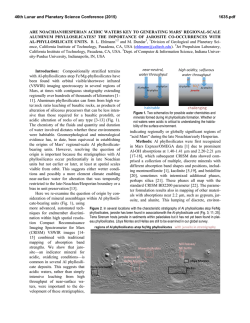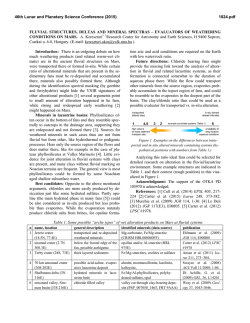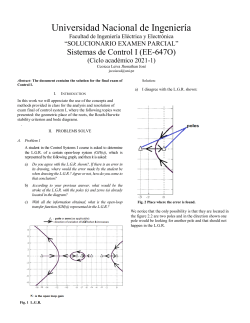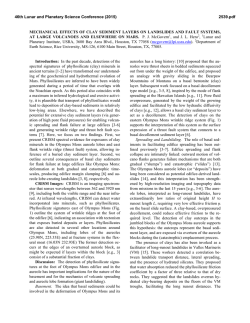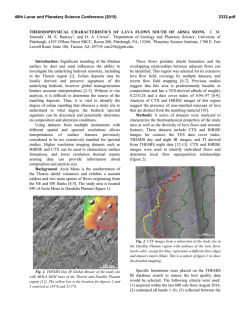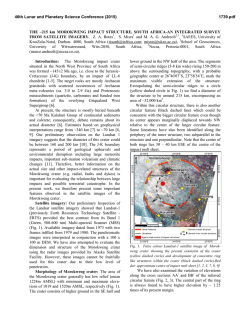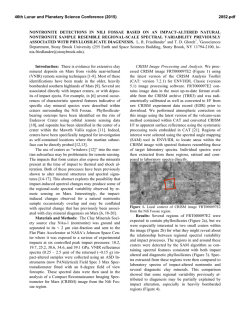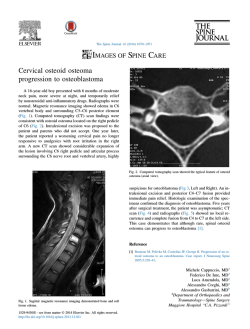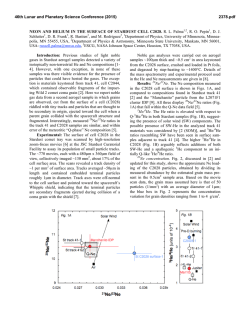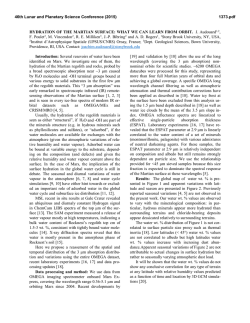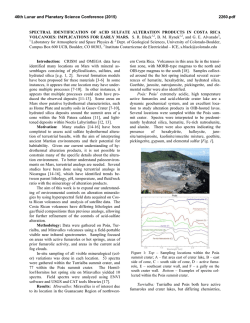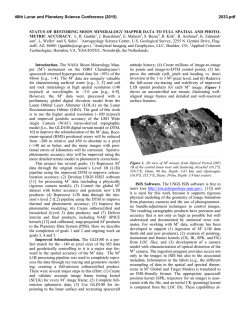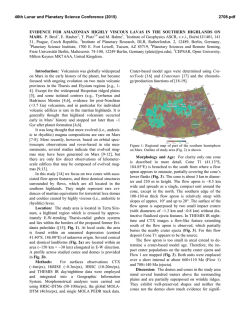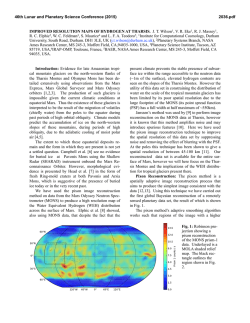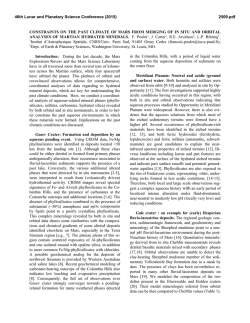
1918
46th Lunar and Planetary Science Conference (2015) 1918.pdf CHLORIDES PREDATED CLAY IN A LACUSTRINE ENVIRONMENT ON MARS AND ITS ASTROBIOLOGY APPLICATION. Jun Huang1, M. R. Salvatore2, P. R. Christensen2 and Long Xiao1, 1 Planetary Science Institute, China University of Geosciences, Wuhan, Hubei, P. R. China ([email protected]), 2 School of Earth and Space Exploration, Arizona State University, Tempe, AZ, USA Introduction: Globally distributed chloridebearing materials have been previously identified on Mars [1] using spectral data from Thermal Emission Imaging System (THEMIS) [2] and Thermal Emission Spectrometer (TES) [3]. These chloride salts (chlorides) are indicators of near-surface water activity in the past, and could have provided habitable environments for haophilic microorganisms and preserved organic matter [4]. However, previous studies have shown many chlorides occurred in local topographic depressions without clear geologic or stratigraphic context [5]. In addition, phyllosilicates have been found to underlie chlorides [6, 7] in many locations, suggesting that these deposits are stratigraphically younger than their surroundings. This proposed young age is not favorable from an astrobiological perspective, given the most likely habitable surface environments on Mars would have occurred very early in martian history [8]. Here we identify the coexistence of chlorides and phyllosilicates in a basin west of Knobel crater (near Gale crater), and show that these chlorides are stratigraphically below iron-magnesium smectite clays. The two distinct depositional events in this MiddleNoachian [9] lacustrine environment can shed light on an environment with interesting astrobiological implications. As such, this site should be considered as a potential site for future martian surface investigations. Methods: We used imaging data from the THEMIS global mosaic (~100 m/pixel) [2,10] and gridded topographic data from the Mars Orbiter Laser Altimeter (MOLA; 128 ppd) [11] to show the overall regional context. Decorrelation stretch (DCS) [12] images of THEMIS and Compact Reconnaissance Imaging Spectrometer for Mars (CRISM) [13] are used to visualize compositional variations. Spectral information was extracted from CRISM FRT data (~18 m/pixel) and compared to library mineral spectra. THEMIS nighttime infrared (IR) data were used to calculate thermal inertia [14]. We further characterized local and detailed geomorphology using Context Camera (CTX: ~6 m/pix) [15] and High Resolution Imaging Science Experiment (HiRISE: ~30 cm/pix) images [16]. Results: Our investigation focuses on a topographically enclosed basin approximately 3000 km2 in area centered near 6.078 °S, 132.346 °E (Fig. 1a). Lighttoned materials can be seen throughout the study region; the largest occurrence is in the northern part of the fan unit, and tens of smaller occurrences are in isolated “geologic windows” (Fig. 2). These lighttoned materials with elevated thermal inertia (Fig. 1b) appear blue (Fig. 1c) in DCS [12] images of THEMIS band 8, 7 and 5 , which is unique to chloride salts [1, 5]. CRISM data were also used to identify and map hydrated materials throughout this basin. In Figure 1d, the red, green and blue channels are assigned to 1.8, 2.38 and 1.15 μm, respectively. This combination causes phyllosilicate-bearing materials to appear red and orange, chloride-bearing materials to appear blue, and low-calcium pyroxene-bearing materials to appear green (Fig. 1d). The regional stratigraphic relationship of different materials can be determined using CTX and HiRISE imagery. At one location (Fig 2c), chloride-bearing materials occur in the lowest topographic regions in both north and south portion and outcrops of pyllosilicate-bearing materials occur directly above the southern chloride exposure. Possible aeolian deposits compose an upper layer, and erosional windows of chlorides can be observed within it. Therefore, the chronologic sequence, from oldest to youngest, appears to be chlorides, phyllosilicates, and aeolian deposits. Similar chronologic relationship of chlorides and phyllosilicates can be determined at another location (Fig 2d). The chloride-bearing materials filled an old crater and resisted subsequent erosion that destroyed the crater rim. Subsequently, phyllosilicatebearing materials were deposited on top of the original rim of this eroded crater. A dark toned material with basaltic composition also occurs stratigraphically above the chloride-bearing materials and is present within the inter-crest plains of chloride deposits (Fig 2e). If the basaltic materials are above the phyllosilicates (Fig 2f), their formation may indicate the end of hydrologic activity in the region. Discussion: The geomorphic and compositional analyses indicate the following sequence of the materials, and we hypothesize their formation environments: 1) Chloride-bearing materials on Noachian base, which were emplaced by high-salinity waters that filled the basin and subsequently evaporated; 2) The observed ridges in chloride-bearing materials were formed by aeolian modification; 3) Phyllosilicate-bearing materials, which was deposited within a very thin layer during transient lacustrine activity that was not capable of dissolving the previously deposited chlorides; 4) An 46th Lunar and Planetary Science Conference (2015) 1918.pdf alluvial fan was formed by continued fluvial activity, which superimposes the underlying chloride- and smectite-bearing deposits; and 5) Aeolian deposits, on top of all of the younger geologic units, were formed by subsequent erosion of the fan. Chlorides and smectite clays have been shown to effectively entrap and preserve microorganisms in terrestrial environments [17, 18]. If ancient Mars was habitable, such a lacustrine setting my have been able to entrap and preserve a record of microbial fossils, should they have existed. The high astrobiological potential of this site makes it an ideal location for future landed mission and possible sample return. Acknowledgements: J. H. was supported by National Natural Science Foundation of China (No. 41403052). References: [1] Osterloo, M.M., et al., Science, 2008. 319(5870): p. 1651-1654. [2] Christensen, P.R., et al.,. SSR, 2004. 110(1-2): p. 85-130. [3] Christensen, P.R., et al., JGR, 2001. 106(E10): p. 23823-23871. [4] Farmer, J.D. and D.J. Des Marais, JGR, 1999. 104(E11): p. 26977-26995. [5] Osterloo, M.M., et al., JGR, 2010. 115. [6] Murchie, S.L., et al., JGR, 2009.114. [7] Glotch, T.D., et al., GRL, 2010. 37(16): p. L16202. [8] Carr, M.H. and J.W. Head, EPSL, 2010. 294(3-4): p. 185-203. [9] Tanaka, K.L., et al., Geological Survey Scientific Investigations Map 3292. [10] Edwards, C.S., et al., JGR, 2011. 116. [11] Smith, D.E., et al., JGR, 2001. 106(E10): p. 23689-23722. [12] Gillespie, A.R., A.B. Kahle, and R.E. Walker, RSE, 1986. 20(3): p. 209-235. [13] Murchie, S., et al., JGR, 2007. 112(E5). [14] Fergason, R.L., P.R. Christensen, and H.H. Kieffer, JGR, 2006. 111(E12). [15] Malin, M.C., et al., JGR, 2007. 112(E5). [16] McEwen, A.S., et al., JGR, 2007. 112(E5). [17] Kennedy, M.J., D.R. Pevear, and R.J. Hill, Science, 2002. 295(5555): p. 657-660. [18] McGenity, T.J., et al., Environmental Microbiology, 2000. 2(3): p. 243-250. Fig. 1 See text for decription. The black box is Fig. 2a Fig. 2 See text for decription. The scale bars are 50 m
© Copyright 2025
